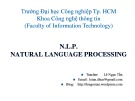
Statistical natural language processing
Xem 1-1 trên 1 kết quả Statistical natural language processing
-
Lecture “Natural language processing – Chapter 5: Foundation of statistical machine translation” has contents: Introduction to statistical machine translation, statistical MT systems, three problems in statistical MT systems, translation model, and other contents.
 12p
12p  dien_vi01
dien_vi01
 21-11-2018
21-11-2018
 21
21
 0
0
 Download
Download
CHỦ ĐỀ BẠN MUỐN TÌM
TOP DOWNLOAD














